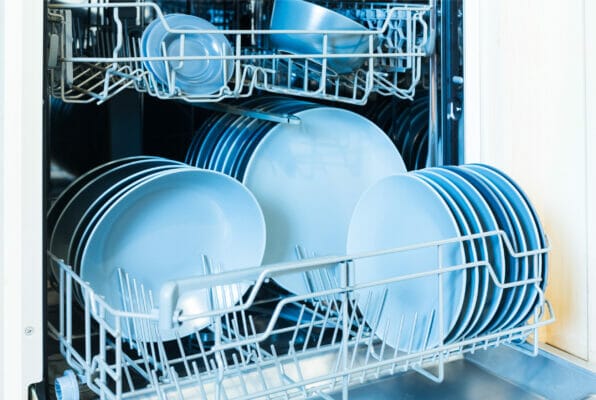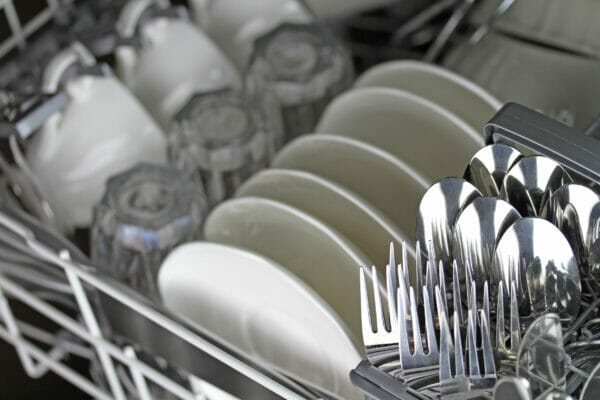Disclaimer: This post may contain affiliate links, meaning we get a small commission if you make a purchase through our links, at no cost to you. For more information, please visit our Disclaimer Page.
Dishwashers use hot water and also heat on their own. They have built-in water heating systems that ensure your dishwasher water reaches the appropriate temperature. You can decide to use hot water in your dishwasher or add cold water to be heated automatically.

Table of Contents
How Hot is Water in A Dishwasher?
The average water temperature for dishwashers is between 120 to 150 degrees Farenheight. The ideal temperature to effectively clean and sanitize your dishes is 140 degrees. The higher the water temperature, the more effective cleaning takes place.
If you use your home’s heated water in your dishwasher, the heating system might heat up the water more if it detects that it is not hot enough. High water temperatures will also help your dishes dry a lot faster after rinsing since the dishes will remain warm.
Will A Dishwasher Work Without Hot Water?
A dishwasher will work with cold water; however, that is not the best option. Cold water cannot kill germs in your dishes. Yes, it will clean the dirt, but it will not kill microorganisms that cannot be seen.
A dishwasher also needs hot water to fully activate detergents and other cleaning agents and effectively dislodge food and grease from your dishes.
For your dishwasher to kill bacteria, the water temperature needs to be at least 140 degrees Fahrenheit.
A dishwasher has heating elements that allow it to detect and increase water temperatures. Not all types of bacteria are killed by this temperature.
Some require a higher temperature of above 200 degrees Fahrenheit, which cannot be achieved inside a regular dishwasher. In this case, you can sanitize your dishes further if need be.
Types of Dishwashers
Built-In Dishwashers
These are the most popular types of dishwashers. They are built-in under benches and come with neither a top nor sides. They are quiet and convenient due to their proximity to food preparation areas.
If you plan to move houses in the near future, a built-in dishwasher may not be suitable as it is a fixed kitchen appliance.
Portable Dishwashers
These are standalone dishwashers that can be moved from one place to another as long as you have somewhere to pump and drain water.
These portable dishwashers come in different sizes so that you can choose one based on available kitchen space.
Countertop Dishwashers
As the name suggests, these dishwashers can be placed on the countertops in your kitchen. They are much smaller than portable dishwashers. They have a low capacity so they are suitable if you do not use a lot of dishes in your home.
They are easy to use and can reasonably free up your kitchen space because of their size.
Drawer Dishwashers
This is a new dishwasher design that has drawers instead of a pull-down door. They are small in size and also suitable for a home without a lot of dishes.
They can have one drawer or two drawers, depending on the kind of capacity you require.
Integrated Dishwashers
Integrated dishwashers are built in your kitchen. They are then integrated with your kitchen aesthetics, for example, to match the color and material of your kitchen cabinets.
What Are The Main Parts of a Dishwasher?
There are a few essential elements in a dishwasher that make them function with ease.
Control Mechanical System
The control mechanism is an integral part of the dishwasher. It is located behind the dishwasher’s control panel.
It serves primary functions like the timer, which determines how long each cycle is. It also dispenses detergent, heats water, and stimulates drainage.
Water Intake Valve
Water from your home enters the dishwasher through this channel. The valve opens and closes to allow the appropriate amount of water to go in during a cycle.
Circulation Pump
The circulation pump is located at the center of the dishwasher beneath the basin. This pump forces water up into the spray arms during dishwashing cycles. It then directs the water to the drainage hose. The pump can either be reversible or direct-drive.
Reversible pumps switch between pumping water to the spray arms and pumping to the drain hose by reversing the motor’s direction. They are vertically mounted.
In direct-drive pumps, the motor only runs in one direction—only the direction of the water switches from the spray arms to the drain hose.
How Do Dishwashers Work?
Dishwashers are fully automated, meaning once you set them up well, they will perform the required functions. The dishwasher adds water and heats it to the appropriate temperature. You can speed up the water heating process by using already heated water in your dishwasher.
Once the maximum heating temperature is achieved, it dispenses detergent, and the cleaning cycle begins. The dishwasher expels water from the pump in jets, and the water is sprayed on the dishes.
The pressure from the hot water enables the sprays to rotate and connect with the dishes. As the cycle continues, water is drained, and the dishes are rinsed once more.
The heating system will then circulate hot air around the dishwasher to dry the dishes. You can choose to do this manually if you wish to save energy.
Dishwashers have self-timers that monitor and regulate each dishwashing cycle. They have sensors that detect both the water and air temperatures and control them accordingly to ensure neither your dishes nor the dishwasher itself gets heat damaged.
Some dishwashers also have sensors that can tell water levels within the dishwasher to prevent it from overflowing. Once the water reaches a certain level, the drainage function is automated, and the water is drained.
Some dishwashers have sensors that read how dirty the water is.
The sensors detect once the water clears up, and the cycles stop since the dishes are clean.

What To Consider When Using a Dishwasher?
There are certain ways you should use your dishwasher to maintain its safety.
Use dishwashing detergent as they counteract mineral deposits in the water, so use more detergent if your area has hard water. They also have solvents that dissolve food particles and cut through stubborn grease.
Do not use dishwashing soap as it will over foam in the dishwasher.
Given how convenient dishwashers are, do not overload them. There needs to be enough space for the detergent to reach the dishes and for the water to spray effectively.
When loading the dishes, face the dirtiest parts towards the spray arms so that water hits them directly first.
Separate items with identical shapes or give them enough space as they might bind together, preventing detergent and water from reaching the dirty, covered bits.
Sort out your metallic items before each cycle, for example, stainless steel and silver. They need to go on the dishwasher separately.
The humid conditions within the dishwasher may cause corrosion between the two metals if they are not compatible.
Delicate items need to be washed by hand as the pressure within the dishwasher may damage them. These include fine china, hand-painted utensils, or those made of wood.
If you are cleaning plastic items, do not put them at the bottom of the rack as they might melt during air drying.
The bits of food that remain on your dishes help the dishwasher maintain a pH level. Therefore, do not pre-clean the dishes.
